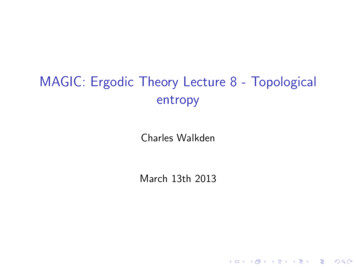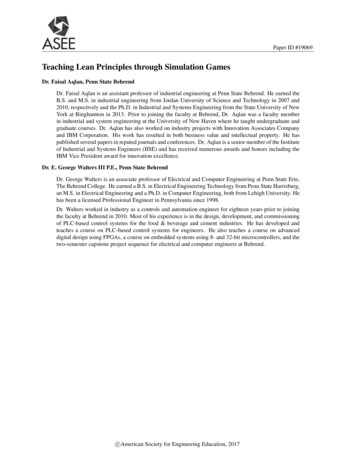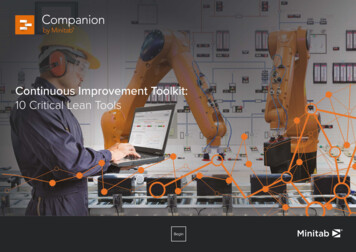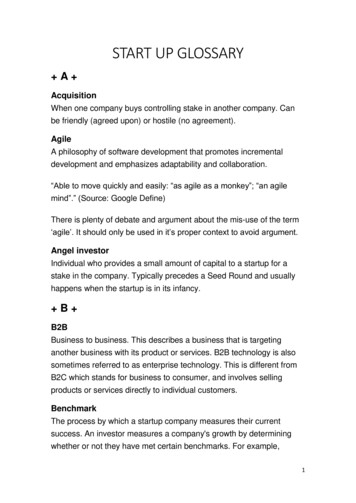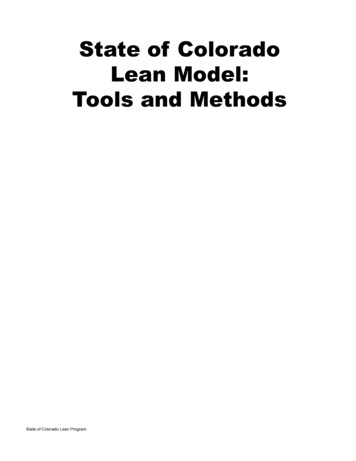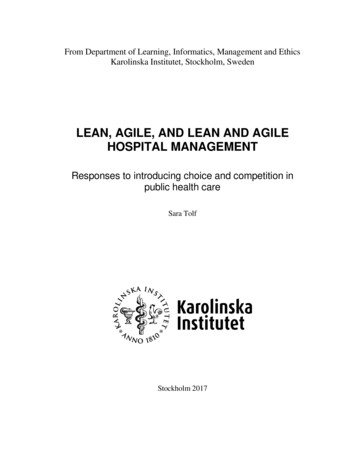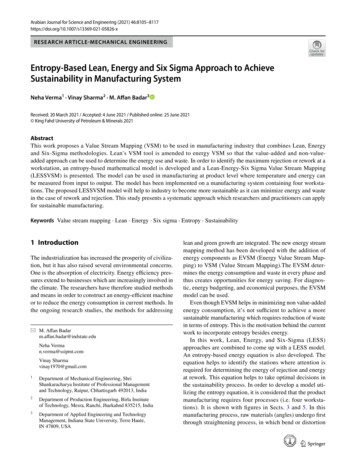
Transcription
Arabian Journal for Science and Engineering (2021) 5826-xRESEARCH ARTICLE-MECHANICAL ENGINEERINGEntropy‑Based Lean, Energy and Six Sigma Approach to AchieveSustainability in Manufacturing SystemNeha Verma1 · Vinay Sharma2 · M. Affan Badar3Received: 20 March 2021 / Accepted: 4 June 2021 / Published online: 25 June 2021 King Fahd University of Petroleum & Minerals 2021AbstractThis work proposes a Value Stream Mapping (VSM) to be used in manufacturing industry that combines Lean, Energyand Six-Sigma methodologies. Lean’s VSM tool is amended to energy VSM so that the value-added and non-valueadded approach can be used to determine the energy use and waste. In order to identify the maximum rejection or rework at aworkstation, an entropy-based mathematical model is developed and a Lean-Energy-Six Sigma Value Stream Mapping(LESSVSM) is presented. The model can be used in manufacturing at product level where temperature and energy canbe measured from input to output. The model has been implemented on a manufacturing system containing four workstations. The proposed LESSVSM model will help to industry to become more sustainable as it can minimize energy and wastein the case of rework and rejection. This study presents a systematic approach which researchers and practitioners can applyfor sustainable manufacturing.Keywords Value stream mapping · Lean · Energy · Six sigma · Entropy · Sustainability1 IntroductionThe industrialization has increased the prosperity of civilization, but it has also raised several environmental concerns.One is the absorption of electricity. Energy efficiency pressures extend to businesses which are increasingly involved inthe climate. The researchers have therefore studied methodsand means in order to construct an energy-efficient machineor to reduce the energy consumption in current methods. Inthe ongoing research studies, the methods for addressing* M. Affan Badarm.affan.badar@indstate.eduNeha Verman.verma@ssipmt.comVinay Sharmavinay1970@gmail.com1Department of Mechanical Engineering, ShriShankaracharya Institute of Professional Managementand Technology, Raipur, Chhattisgarh 492013, India2Department of Production Engineering, Birla Instituteof Technology, Mesra, Ranchi, Jharkahnd 835215, India3Department of Applied Engineering and TechnologyManagement, Indiana State University, Terre Haute,IN 47809, USAlean and green growth are integrated. The new energy streammapping method has been developed with the addition ofenergy components as EVSM (Energy Value Stream Mapping) to VSM (Value Stream Mapping).The EVSM determines the energy consumption and waste in every phase andthus creates opportunities for energy saving. For diagnostic, energy budgeting, and economical purposes, the EVSMmodel can be used.Even though EVSM helps in minimizing non value-addedenergy consumption, it’s not sufficient to achieve a moresustainable manufacturing which requires reduction of wastein terms of entropy. This is the motivation behind the currentwork to incorporate entropy besides energy.In this work, Lean, Energy, and Six-Sigma (LESS)approaches are combined to come up with a LESS model.An entropy-based energy equation is also developed. Theequation helps to identify the stations where attention isrequired for determining the energy of rejection and energyat rework. This equation helps to take optimal decisions inthe sustainability process. In order to develop a model utilizing the entropy equation, it is considered that the productmanufacturing requires four processes (i.e. four workstations). It is shown with figures in Sects. 3 and 5. In thismanufacturing process, raw materials (angles) undergo firstthrough straightening process, in which bend or distortion13Vol.:(0123456789)
8106Arabian Journal for Science and Engineering (2021) 46:8105–8117present in raw materials is removed. After this, anglesundergo CNC, in which punching, stamping & cutting operations are performed. After CNC, notching is performed onthe angles and then all products undergo galvanization. Ingalvanization, a protective coating of zinc is applied on theangles and cleats. Here manufacturing process is completedand all the products are sent for packaging. Each processwill lead to an increase in the temperature of the work-piece,which increases the entropy of both the work-piece and theuniverse. It is assumed that rework and rejection at any pointin the system will lead to an increase in entropy of the universe and this can be identified by the proposed Lean EnergySix Sigma VSM (LESSVSM) model.Besides the development of the sustainable LESSVSMmodel, this article discusses the application of the modelin a case study with a manufacturing system comprisingfour workstations. There does not exist enough studies in theliterature showing stepwise details of the use of energy andentropy for sustainable manufacturing systems in industries.The present work is an attempt to make contribution in thisregard. The LESSVSM model minimizes waste and helpstowards sustainability.The article is organized as follows. Next section coversliterature review related to Value Stream Mapping, EnergyValue Stream Mapping, Lean, and Six Sigma. Section 3explains Lean, Energy, and Six Sigma model for an example product from the industry. Section 4 presents the newentropy based mathematical model for Lean, Energy, andSix Sigma Value Stream Mapping. Section 5 illustrates themodel implementation. Section 6 discusses the results. Section 7 describes the conclusions and recommendations.2 Literature ReviewThis section discusses the literature review related to Lean,Six Sigma, Lean Six Sigma, Value Stream Mapping (VSM)and Energy VSM.2.1 Lean, Six Sigma and Lean Six SigmaLean technique emphasizes waste elimination [8, 53]and reduction of flow time between process steps [9].Six Sigma methodology emphasizes process optimization by reducing variation [4, 18, 47]. Because Lean andSix Sigma both are process improvement techniques andhave similarity in their goals and procedures, these arealso combined as Lean Six Sigma methodology [43, 47].Lean Six Sigma (LSS) tools address the waste generatedduring the process, identify and eliminate the non-valueadded activities, and reduce process variations [32]. Avariety of studies have been done to study the impact ofthese LSS tools in manufacturing and service industries13as well as non-profit organizations. Edgeman and Dugan[21] have discussed the use of Six Sigma in military anddefence applications as well as pertaining to society andenvironment.The effect of Lean tools like 5S, value stream mapping(VSM), Total productive maintenance, and Six Sigma toolslike DMAIC (Define, Measure, Analyze, Improve, andControl) has been studied in a die manufacturing industry[51]. A Lean tool: observation is used to eliminate wasteand identify causes of variations [7]. DMAIC approach hasbeen used to improve productivity in a caravan manufacturing company in the UAE [30]. A study has been done on theexisting Six Sigma methodologies and quality improvementprocedures in a small engineering firm in the USA, whichsuggested a plan to improve service quality and customersatisfaction [10]. A modified version of DMAIC has beenapplied to decrease defects produced in an automotive partmanufacturing company in India [36]. DMAIC approach isutilized in sheet metal forming process of deep drawing tominimize defects [1]. DMAIC has been adopted in textileindustry of Bangladesh to decrease defects in denim fabricmanufacturing [44]. A framework using analytic hierarchyprocess (AHP) and DMAIC to improve supply chain performance of manufacturing companies has been proposed [41].A Lean and sustainability principle is applied to determinethe performance of manufacturing sustainability in an Indonesian furniture industry [27]. Similarly Lean concepts areused to design a facility layout for a cylinder liner production line in China [55]. The designed layout increased theproduction efficiency. Six Sigma approach is also applied ina semiconductor company that used to produce cartridgesfor printers [48]. It helped to decrease defects in the manufacturing process.DMAIC is applied in a UAE telecom company to improvecustomer satisfaction by decreasing the response time tocustomer requirements [43]. Pareto chart, cause and effectdiagram, Kaizen, 5S, etc. are used to improve the businessprocess of an interior design company located in the middle-east region [31]. LSS is also applied to improve serviceprocess in a higher education institution [35]. The authorsalso discussed the challenges faced while working with theintangible factors. The intangible impacts of LSS are analysed and reported that LSS can foster organizational innovation [2]. A review on the application of Lean, Six Sigma,or LSS initiatives in the food industry has been conducted[17] and concluded that these initiatives would decrease costand imporve productivity. DMAIC methodology is appliedin a business entity in Croatia to decrease delivery times ofproducts in order to be competitive in the global market [39].An investigation has been done if Lean and SS principlescan be applied in public housing authorities in the USA.With a case study, it showed that these concepts can improvean affordable housing process [33].
Arabian Journal for Science and Engineering (2021) 46:8105–8117A systematic review of literature on the application of SixSigma approach in healthcare is presented in [5]. This workcan be used as a guide in improving the quality of healthcare. An ILL (Innovativeness, Learning and Lean) index isdevised to evaluate and improve healthcare organizations[19]. Identification of key factors has been done that aretied with successful continuous improvement in hospitalswhile implementing quality improvement methodologiessuch as Lean-Kaizen, SS, LSS. [25]. Lean technique is utilized to identify waste in a hospital emergency departmentto decrease patient length of stay [40]. Lean healthcare principles are adopted to devise an operating room effectivenessindicator, which can measure the performance and identifywaste in hospital operating rooms [46]. The adaptation ofthis indicator in a university hospital in Brazil resulted in anincrease in the operating room efficiency. DMAIC is alsoused in a healthcare setting for patient surge planning dueto the COVID-19 pandemic [12].2.2 Value Stream Mapping (VSM) and Energy VSMA Lean incipience spiral model is proposed as a Lean transformation framework to be used in small and medium enterprises (SMEs) [16]. SMEs can sustain this transformation asit is guided by value stream mapping (VSM). In VSM, timefor value-added and non-value-added activities are shown.VSM has been used to address problems like rejections,inventories, waiting time, setup time in a die manufacturingindustry [51], where a decrease in wastage and an increasein productivity was achieved. VSM has also been applied ina simulated manufacturing company in an academic setting[3]. Adding energy consumption to value stream makes itenergy value stream, which can be used to address the wastage of energy in any process chain of a manufacturing system [22]. This visual display of energy waste helps the planner to manage efficiently. But the idea of added value andnon-value consumption does not propose a way to computethe time and energy input simultaneously, which in turn contributes to a concept of energy loss due to non-value addedactivities. To avoid this, Muller et al. [37] in their energyVSM (EVSM), evaluated time and energy inputs simultaneously to optimize value-streams including the transportationprocesses which are essential parts of supply chains. Theincorporation of transport into energy VSM demonstratesthe impact of prolonging lead time as a way of adding valueto energy consumption [20]. When the output cycle is analysed, it reveals that during the full cycle there is a trend ofenergy consumption depending on the state of the machine.Installation, set-up, idle, and processing or production statusare various states of the machine or system corresponding todifferent power levels [11]. This EVSM approach allows foran analysis of energy consumption during non-value-addedwork. The energy audit records the power level for each state8107[11]. It discusses the thematic state of the system and assignsenergy level. Every state has its own value-added energy andnon-value-added energy. When the device is set, it communicates the consumption of energy and its control.The VSM is also effectively utilized in the process ofplanning to visualize and reduce waste [38]. The currentstate of the use of energy value stream mapping (EVSM)has been described in [52]. The waiting time is eliminated byKanban (pull system). Verma & Sharma [50] used EVSM toaddress the non-productive energy consuming processes andto focus on achieving Green Manufacturing. The energy estimation is based on Lean modelling as value added and nonvalue added in order to holistically maximise value sources.This definition uses simulation to construct a dynamic VSM,which allows more complex systems than conventionalVSMs to be analysed. This allows the Lean coordinator toenvision the outcomes in an easily understandable language[50]. Value stream mappings can be updated in a table tomake the teams compatible [45]. The paper shows the inability to thoroughly and adequately address industrial needsof "existing methods to manufacturing calculation, control,and energy efficiency improvement" [45]. The absence ofeffective instruments to recognize energy use and the waysto enhance energy effectiveness has created a gap betweenliterature and industrial needs [14].Pioneering stream mapping strategies have been proposed to improve energy efficiency in small and mediumsized manufacturing sectors [49]. Potential scenarios forexploring potential changes are also developed via Bayesian networks. Not only can the proposed model be used fordiagnosis, but also for energy budgeting and saving measures. In view of the machinery’s state energy use, visualization of the energy usage has been considered as important[29]. The total energy consumption of the company is takeninto account in an integrated energy stream mapping. Theprocess box identifies energy consumption in different production steps, but the energy wastes are linked to the nonvalue-added activity of the traditional VSM. In the valueadded activity could be hidden energy non-value-added step,which is not considered. The focus is on the factory level,not on the product level [13]. Energy Value Stream Mapping(EVSM) as a method for determining energy consumptionduring any phase of development is also explored in [15] inthe development of bio diesel. The first approach that mapsthe sustainable value stream and accounts for the energyconsumption for two direct and indirect categorizations ispresented in [23]. Direct energy for supporting operationsand auxiliary equipment is divided into theoretical energyand auxiliary energy. For all products is then calculated theembodied energy as the sum of theoretical, auxiliary, andindirect energy consumption. EVSM is used to determineenergy wastage in an auto body paint shop of an automobilemanufacturing company [42].13
8108Arabian Journal for Science and Engineering (2021) 46:8105–8117VSM is presented in combination with energy lossequations and heat energy rate analysis to reduce energyloss in a power plant [6]. Environmental VSM is used inlean manufacturing work at Volvo [34]. DMAIC-basedmethodology is proposed to use sustainable VSM for sustainable manufacturing [28]. The terminology of GreenLean Six Sigma for sustainable VSM is adopted in [24].An operational entropy model of operation-logistics systems in order to determine the operational efficiency hasbeen developed and used in a case study in [54].It is evident from the literature that sustainableVSM utilizing energy and entropy is a growing fieldfor researchers and practitioners. However, there are noenough studies showing how to use sustainable VSM insustainable manufacturing systems. The present research isan attempt to fill this gap. This work employs the conceptsof Lean, Energy, and Six Sigma and presents a model thatincludes entropy. The model will help minimize waste andaid towards sustainability.3 Lean Energy Six Sigma ModelFigure 1 displays the proposed Lean Energy Six Sigma(LESS) model. Starting with the application of the leanenergy, all waste including energy is then applied to thesystem. Six-sigma instruments are then used to refine theprocess and reduce uncertainty, eliminating energy usageduring the product life cycle. The model is named LESS(Lean, Energy, Six-Sigma) by the application of the toolsin the system to achieve sustainability.Fig. 1 Lean energy six sigma (LESS) modelFig. 2 Process flow line taken for value stream mapping133.1 Value Stream Mapping (VSM)Galvanized angles and cleats having holes stamp and notchare the products that are being manufactured from input (i.e.angles) by four processes. Raw materials (angles) undergo firstthrough straightening process, in which bend or distortion present in raw materials is removed. After this, angles undergoCNC, in which punching, stamping & cutting operations areperformed. After CNC, notching is performed on the anglesand then all products undergo galvanization. In galvanization,a protective coating of zinc is applied on the angles and cleats.Here manufacturing process is completed and all the productsare sent for packaging. Figure 2 shows the process flow diagram of the product used for the creation of the model andFig. 3 shows its present value stream mapping (VSM).The information which is collected from the current VSMis: Machine name, Energy (E), Cycle time (CT), Change overtime (C/O), Number of workers engaged, the calculation isbeing made for a cycle time of each operation. For each operation, data are collected for five consecutive cycle and averagedata are considered for VSM. It is observed that the cycle timeof the galvanization process deviates too much from the takttime of 39 s, hence the bottleneck exists here in Fig. 4. Packaging is not a part of the manufacturing process, rather it is a partof the supply chain. Packaging is done to provide products tothe customers safely. Hence, Fig. 4 does not show packaging.By successful implementation of the new LESSVSM modelas proposed in Sect. 5 and shown in Fig. 7, the bottleneckingcan be minimized.3.2 Energy Value Stream Mapping (EVSM)The energy value stream mapping (EVSM) is created by taking into account the energy usage for each time-related valueadded (VA) and non-value-added (NVA) activities. The relevant data are collected on the basis of each operation and thecorresponding value is summarized in Table 1 and EVSM isshown in Fig. 5. Comparing energy NVA (ENVA) with thecorresponding energy VA (EVA), it’s clear that the notchingconsumes the highest proportion of ENVA compared to itscorresponding EVA. The values shown in Fig. 5 are obtainedfrom the time study and motion study of manufacturing processes and the values of EVA and ENVA shown in Table 1 areobtained by energy calculation for the four processes. Packaging was not shown in Fig. 4 as explained in Sect. 3.1.VSM (Fig. 4) displays takt time and provides informationrelated to different processes, inventories etc. But EVSM
Arabian Journal for Science and Engineering (2021) 46:8105–81178109Fig. 3 Current value streammapping(Fig. 5) consists of all information of VSM as well as represents energy consumption for value added & non valueadded activities i.e. EVA & ENVA.3.3 LESS ModelSix Sigma is the data-based approach that improves processcapabilities and increases the performance of process anddecreases the variation. Six Sigma’s DMAIC tool is used inthe current work. A concise description of all the phases ofDMAIC: Define, Measure, Analyze, Improve, and Control[30] is presented here.Fig. 4 The bottleneck in the process lineTable 1 Energy Calculation for different processesProcess/DataStraightening CNCNotchingGalvanizationEnergy (KW)C/TC/OEVAENVATotal Energy221.15 min7 min0.421 kWh2.57 kWh2.991 kwh2227 s6 min0.165 kWh2.2 kWh2.385 kWh96.5510 min6 min16.09 kWh9.655 kWh25.745 kWh154 min5 min1kwh1.25 kWh2.25 kWh1. Define:—In this phase various problems and complications associated with manufacturing process such aswaste, rejection & rework due to energy consumptionand dissipation are identified. This phase provides information about all process parameters such as inputs andoutputs of manufacturing processes, suppliers and customers.2. Measure:—Information gained from the define phasehelps to measure process parameters and collect data.In this phase, a Lean tool: value stream mapping (VSM)can be used. For the present production shown in Fig. 2,the corresponding VSM is displayed in Fig. 3 andexplained in Sect. 3.1.13
8110Arabian Journal for Science and Engineering (2021) 46:8105–8117Fig. 5 Energy value streammapping (EVSM)3. Analyze:—In the ‘analyze’ phase, energy consumed invalue-added (EVA) and non-value-added (ENVA) activities have been determined as discussed in Sect. 3.2, andEVSM has been shown in Fig. 5. This provides a greatinformation about energy consumption in value addedtasks such as manufacturing operations and energy dissipation due to non-value added tasks such as rejection.4. Improve:—Energy dissipation that occurs due to rejection and rework can be reduced by minimizing rejection and rework rates (%). Entropy based mathematicalmodel is proposed for this phase which helps to identifyrejection and rework % by using energy and entropy concepts. The detailed discussion is given in Sect. 4.5. Control:—This phase deals with physical behaviourof the proposed model i.e. whether this model sustainsa real manufacturing environment or not. Hence theentropy based model is implemented on the current production with the four manufacturing processes. This hasbeen explained in Sect. 5.Since this work deals with integrating Lean thinkingand energy savings in manufacturing processes throughthe Six Sigma tool, the proposed model is named as“LESS” model.134 Entropy Based Mathematical ModelFor Lean Energy Six Sigma Value StreamMapping (LESSVSM)The next step is to minimize process variability and defectsafter the energy waste is minimized by eliminating the nonvalue added energy shown earlier in EVSM. A mathematical model based on system entropy is built to define themechanism where maximum rejection and rework occur.The following assumptions have been made to develop thismathematical model:1. Six sigma’s DMAIC methodology is followed strictly.2. Manufacturing process is considered as an isolated system.3. Rejection and rework increase entropy of the system.4. Temperature values for each process can be measured.5. Energy consumption values for rejection and rework canbe determined.
Arabian Journal for Science and Engineering (2021) 46:8105–81178111Let,ΔS Change in entropy from state 1 to state 2ΔQ Change in Heat EnergyΔU Change in Internal energy of a systemΔW Change in Work done by the systemT1 Inlet temperatureT2 Outlet temperatureTsys System temperatureQME Heat Energy interaction between the manufacturing subsystemWME Work is done between the manufacturing subsystemHPROD Enthalpy of all products, of the manufacturing systemHMAT Enthalpy of all material, of the manufacturing systemHRES Enthalpy of all Residual, of the manufacturing systemQ0 Heat interaction between manufacturing system and the environment, denoted by the subscript “o” is assumed to be out of the systemMi mass of a substanceCp specificheatΔW Work done during productionΔU Internal energyH EnthalpyQi Heat energy for process iQi(MF) , Heat interaction from the material to the environment for the time in which material is exposed to the environmentUtilizing the heat energy and work done equations for thesteady-state equation as proposed by [26](1)ΔQ ΔU ΔW()]Q T1 T2QQΔS T1 T2T1 T2[WME Q0(MF) QME Ei and neglecting the enthalpy of material()where Q0(MF) mi Cp T1 T2() )( WME mi Cp T1 T2 QME(4)()mi .cp . T1 T2 Ei Uprod(MF) Wprod(MF)(5)[H ΔU ΔW](2)WME Wprod(MF) n i()mi .cp . T1 T2 Ei Uprod(MF)(6)Uprod(MF) Epi HMAT(MF) HPROD(MF) HRES(MF)n i HMAT(MF) HPROD(MF) HRES(MF)iiiand residue. )( WME mi Cp T1 T2 Ei HPROD(MF)WME )QME iThe work done at different stages can be represented as(Let(3)Fig. 6 Manufacturing systemfor analysis13
8112Wnet Arabian Journal for Science and Engineering (2021) 46:8105–8117n ()mi .cp . T1 T2 Ei Ep(7)ΔQ N Ei n iQ(MF) ()mi cp Ti To Ei Ep(11)in ()mi .cp . Ti To(8)i]()[n T 1 T2()mi .cp . Ti To Ei EpN.Ei ΔS T1 . T 2i()T1 T2 []ΔS (N 1) Ei Ep Q1(MF)T1 T25 Implementation of the LESSVSM ModelConsider the same product with the manufacturing processesas shown in Fig. 2. This manufacturing system has four processes or workstations between inlet and outlet as shownin Fig. 6. It is assumed that each process in the system willlead to an increase of entropy of both the work-piece and theuniverse. Any rework or rejection at any point in the systemwill cause the entropy of the system to increase further.Let, the temperature of inlet material is T 1 and the temperature of the outlet material is T2.Let,N Batch sizeEi Energy consumed in each workstationm No. of products Reworked in a batchEj Additional energy consumes for reworkr No. of components Rejected in a batchEK Energy consumes when the workpiece is rejectedEp Energy consumes when rework and rejectionES When there are rework and then rejection or rejectionand then rework at one or more workstationsEN Energy consumes when the workpiece is reworkedn number of workstationsZ Total Energy(12)(13)Condition-2: When there is rework(s) at one and moreworkstation for one or more workpiece Z Total energy Nn Ei miΔQ (N m) Ei m (14)Ejjm (mEi mEj)j 1 n ()mi cp Ti To Ei Ep(15)iΔS ()T1 T2[T1 T2(N m) Ei m (mEi mEj)j 1 n ()mi cp Ti To Ei Ep(16)]iThe total energy consumed in the system can be writtenas equation 9Total energy(Z) Energy consumed during value added process(EVA) Energy consumed during nonvalue added process(ENVA) Energy consumed due to rework(s)(ERW)(9) Energy consumed due to rejection(s)(ERJ)Assuming ENVA has been taken care of by EVSM, therewill be four idealistic conditions.Condition-1: when there is no rejection or rework,Z Total energy Nn i13Ei(10)()T1 T2 []ΔS (N 1) Ei m EN Ep Q2(MF) (17)T1 T2Condition-3: When a workpiece is being rejected at oneor more workstation
Arabian Journal for Science and Engineering (2021) 46:8105–8117Z Total energy Nn Ei riΔQ (N r) Ei k 8113(18)Ekjr (r Ek r Ek)k 1 n ()mi cp Ti To Ei Epi(ΔS T1 T2(19))T1 T2[Ei r (r Ek r Ek)k 1 n ()mi cp Ti To Ei Epi]Fig. 8 Findings of energy value stream mapping (EVSM)(20)()T1 T2 []ΔS (N 1) Ei r ES Ep Q3(MF) (21)T1 T2Z Total eney Nn iEi mm jEj rr kEk(22)Condition-4: When there are rework and then rejectionor rejection and then rework at one or more workstations,Fig. 7 LESS value streammapping13
8114Arabian Journal for Science and Engineering (2021) 46:8105–8117ΔQ (N m r) Ei m (mEi mEj6 Results and Discussion)j 1 r (r Ek r E kk 1n ))(mi cp Ti To Ei Ep(23)i(T1 T2ΔS )[T1 T2 r ((N m r) Ei mEi mEjj 1)r E k r Ek k 1m (n )]()mi cp Ti Toi Ei Ep(24)()T1 T2 []ΔS (N 1) Ei m EN r ES Ep Q4(MF)T1 T2(25)Converting (13), (17), (21), (25) in matrix form N 1 N 1 N 1 N 10m0m00rr 1 Ei Q1(MF) 1 EN Q2(MF) 1 ES Q3(MF) 1 EP Q4(MF) From the matrix, the values of all the unknowns (m, r) canbe calculated. The matrix can be solved using MATLAB.From Fig. 5: E1 2.991 Kwh; E2 2.25 Kwh; E3 2.365 Kwh; E4 25.7 KwhTotal no. of components per day 700 piece/day 30piece/hr.Now from case study mass and temperature are:mo 20 kg, m1 19 kg, m2 18 kg, m3 17 kg, m4 15 kg,T1 270 300K, T2 1270 400KTA 520 325K, TB 730 346K, TC 970 370K,Cp 0.49 KJ/kgKPercentage of rework (.09744/700) 0.0139 %Percentage of rejection (.050291/700) 0.0071 %The workstation where the highest rework and rejectionoccur is workstation 4. Based on the information generatedfrom the model, EVSM is modified to LESSVSM and isshown in Fig. 7. This is the most effective tool for the industry as this value stream mapping will address, in totalitythe wastage in any system, and make it the most effectivetowards sustainability.13In this research work lean thinking is integrated to optimizeamount of rejection & rework by utilizing energy consumption in particular workstation. The energy consumption forboth value added (EVA) & non value added (ENVA) isshown in Fig. 8, which can be identified and calculated byimplementing EVSM (Fig. 5).Figure 8 gives a summary of essential information regarding energy consumption. It can be observed that galvanization process is the highest energy consuming workstationincluding both EVA & ENVA. It is also observed that thegalvanization has higher EVA value than that of ENVAwhile the other three processes (workstations) have lesserEVA than ENVA. ENVA is the energy that is wasted ordo not add any value i.e. energy wasted due to rejectionof products. It indicates that EVA of galvanization alsoincludes energy consumed for rework of materials, whichsignificantly add values on products but increases productioncost and lead time, also causes obstacle for a continuous andsmooth production flow.The percentage of rework and rejection is 0.0139%and 0.0071%, respectively, which is calculated from theproposed entropy based LESSVSM model. The amountof rejection a
Six Sigma, Lean Six Sigma, Value Stream Mapping (VSM) and Energy VSM. 2.1 process in a higher education institution [Lean, Six Sigma and Lean Six Sigma Lean technique emphasizes waste elimination [, 53] 8 and reduction of ow time between process steps []. 9 Six Sigma methodology emphasizes
